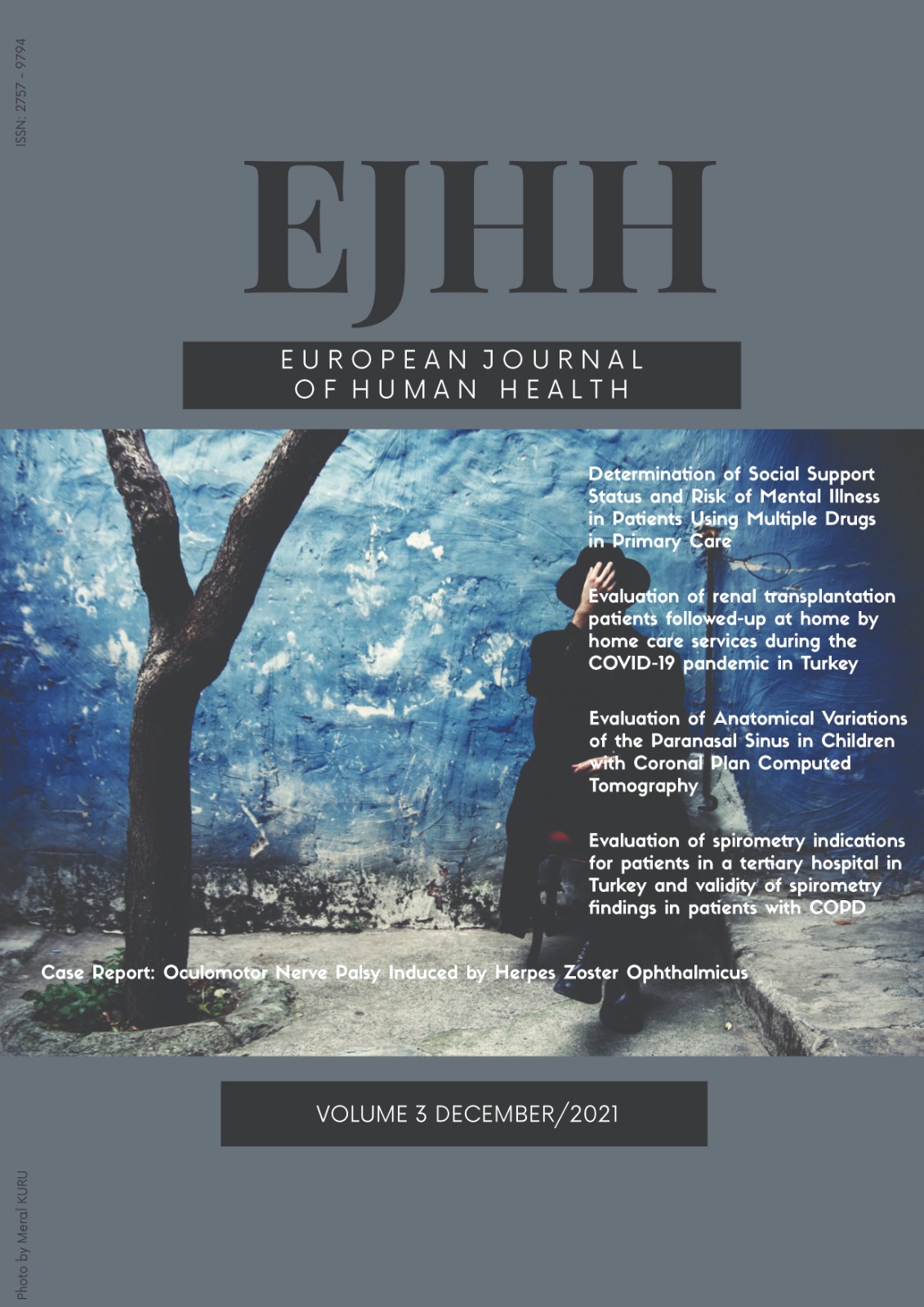Evaluation of spirometry indications for patients in a tertiary hospital in Turkey and validity of spirometry findings in patients with COPD
Author :
Abstract
Keywords
Abstract
Aim: Diseases of the respiratory system are among the most common medical conditions and cause considerable morbidity and mortality. This study aimed to identify the indications for spirometry in a tertiary hospital in Turkey and validity of spirometry findings in patients with COPD.
Methods: A total of 1551 patients were included in the study. Spirometry testing (FEV1, FCV and FEV1/FCV) was performed in the pulmonary function test unit. The height and weight of the patients were also recorded.
Results: The most common reasons for performing spirometry were to evaluate symptoms, signs and laboratory results (55.1%, n=854), to decide on treatment approaches (55%, n=853) and to determine the course of the disease (12.7%, n=197). The most common conditions diagnosed were asthma (25%, n=388), seasonal allergic rhinitis (23%, n=356), cough (15.2%, n=235), bronchitis (12.4%, n=193) and dyspnea (11.4%, n=177). The areas under the curve (AUC) values for FEV1/FVC, FEV1 and FCV in predicting chronic COPD were 0.77, 0.73 and 0.66, respectively. The cut-off point for FEV1/FVC was 78.4%. The sensitivity and specificity of the FEV1/FVC ratio for predicting COPD were calculated as 67.4% and 79.1%, respectively.
Conclusions: In this study, we determined that the physicians’ indications for spirometry deemed appropriate in our region. Although spirometry indications vary, physicians mostly used spirometry to determine the severity of the disease and the diagnosis.Physicians ordering pulmonary function tests and diagnosing chest conditions from these tests should be updated regularly to prevent misdiagnosing.
Keywords
- 1. Evans SE, Scanlon PD. Current practice inpulmonary function testing. Mayo Clin Proc. 2003;78(6):758-63; quiz 63.
- 2. Mannino DM. COPD: epidemiology,prevalence, morbidity and mortality, and diseaseheterogeneity. Chest. 2002;121(5 Suppl):121S-6S.3. Nwosu NI, Chukwuka CJ, Onyedum CC,Odilinye HC, Nlewedim PI, Ayuk AC. Currentpattern of spirometry utilisation in a sub-SaharanAfrican country. African Journal of Respiratory Medicine. 2016;12(1):15-20.
- 4. Lozano R, Naghavi M, Foreman K, Lim S,Shibuya K, Aboyans V, et al. Global and regionalmortality from 235 causes of death for 20 agegroups in 1990 and 2010: a systematic analysisfor the Global Burden of Disease Study 2010. Lancet. 2012;380(9859):2095-128.
- 5. Turkish Statistics Institute. [Mortalitystatistics 2018] (in Turkish) [Available from:https://www.tuseb.gov.tr/enstitu/tacese/haber_ detay.php?id=193.
- 6. Crapo RO. Pulmonary-function testing. N Engl J Med. 1994;331(1):25-30.
- 7. Ferguson GT, Enright PL, Buist AS, HigginsMW. Office spirometry for lung healthassessment in adults: a consensus statementfrom the National Lung Health Education Program. Respir Care. 2000;45(5):513-30.
- 8. García-Río F, Calle M, Burgos F, Casan P,del Campo F, Galdiz JB, et al. Spirometry. Archivos de Bronconeumologica. 2013;49(9):388-401.
- 9. Miller MR, Hankinson J, Brusasco V,Burgos F, Casaburi R, Coates A, et al.Standardization of spirometry. European Respiratory Journal. 2005;26:319-38.
- 10. Onyedum CC, Chukwuka CJ. Indications forSpirometryata Tertiary Hospital in South East,Nigeria. Nigerian Journal of Clinical Practice. 2009;12(3):229-31.
- of Respiratory and Critical Care Medicine. 1994;152:1107-36.
- 12. Meo SA. Significance of spirometry indiabetic patients. International Journal of Diabetes Mellitus. 2010:47-50.
- 13. Richards JA. Office spirometry-indicationsand limitations. South African Family Practice. 2006;48(2):48-51.
- 14. Sewa DW, Ong TH. Pulmonary FunctionTest: Spirometry. Proceedings of Singapore Healthcare. 2014;23(1):57-64.
- 15. Luize AP, Menezes AM, Perez-Padilla R,Muino A, Lopez MV, Valdivia G, et al. Assessmentof five different guideline indication criteria forspirometry, including modified GOLD criteria, inorder to detect COPD: data from 5,315 subjects inthe PLATINO study. NPJ Prim Care Respir Med. 2014;24:14075.
- 16. Chan B, Anderson G, Dales RE. Spirometryutilization in Ontario: practice patterns and policy implications. CMAJ. 1997;156(2):169-76.
- 17. d'Andiran G, Schindler C, Leuenberger P.The absence of dyspnoea, cough and wheezing: areason for undiagnosed airflow obstruction? Swiss Med Wkly. 2006;136(27-28):425-33.
- 18. Miravitlles M, de la Roza C, Morera J,Montemayor T, Gobartt E, Martin A, et al. Chronicrespiratory symptoms, spirometry and knowledgeof COPD among general population. Respir Med.19. Vafaei I, Bilan N, Ghasempour M. Validityof Spirometry for Diagnosis of Cough VariantAsthma. International Journal of Pediatrics.20. Neopane A, Poudel M, Pradhan B, RegmiS, Karki DB. Spirometry in evaluation ofrespiratory diseases. JNMA J Nepal Med Assoc.21. Pellegrino R, Viegi G, Brusasco V, CrapoRO, Burgos F, Casaburi R, et al. Interpretativestrategies for lung function tests. Eur Respir J.22. American Thoracic Society. Lung functiontesting: selection of reference values andinterpretative strategies. American ThoracicSociety. Am Rev Respir Dis. 1991;144(5):1202-18.23. Baur X, Isringhausen-Bley S, Degens P.Comparison of lung-function reference values. IntArch Occup Environ Health. 1999;72(2):69-83.
- 24. Roca J, Burgos F, Sunyer J, Saez M, ChinnS, Anto JM, et al. References values for forcedspirometry. Group of the European CommunityRespiratory Health Survey. Eur Respir J.25. Backman H, Lindberg A, Sovijarvi A,Larsson K, Lundback B, Ronmark E. Evaluation ofthe global lung function initiative 2012 referencevalues for spirometry in a Swedish population sample. BMC Pulm Med. 2015;15:26.
- 26. Thompson BR, Stanojevic S, Abramson MJ,Beasley R, Coates A, Dent A, et al. The all-agespirometry reference ranges reflectcontemporary Australasian spirometry. Respirology. 2011;16(6):912-7.
- 27. Kocabas A, Kara K, Ozgur G, Sonmez H,Burgut R. Value of preoperative spirometry topredict postoperative pulmonary complications. Respiratory Medicine. 1996;90:25-33.





